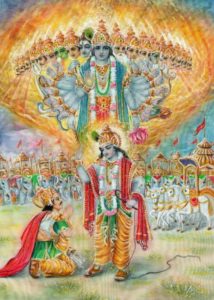 “Whenever righteousness is on the decline and unrighteousness is on the ascendant, then I embody Myself for the protection of the virtuous, for the destruction of unrighteousness and for the re-establishment of righteousness.”
“Whenever righteousness is on the decline and unrighteousness is on the ascendant, then I embody Myself for the protection of the virtuous, for the destruction of unrighteousness and for the re-establishment of righteousness.”
These words of Bhagavan Shri Krishna in Chapter Four, verses 7-8 of Bhagavad Gita ring true from age to age and are borne out clearly in the ‘leelas’ or dramas of the various incarnations during their sojourn on earth. Various scriptural texts record the activities of the Lord on earth in His many manifestations. The Shrimad Bhagavatam is one such compilation, documenting at great length, the many ‘leelas’ of the Divine. In His manifest form of Shri Krishna, the Lord champions the cause of His devotees, destroys evil and restores the state of righteousness to the world.
Through the example of Bhagavan Shri Krishna, man is provided with a treatise on life. Philosophically represented, Shri Krishna symbolises ecstasy borne out of perfection. Lessons on the paths of ‘karma’, ‘gyaan’ and ‘bhakti’ thread through the myriad episodes as the various characters replicate qualities in light of that need to be illuminated or extinguished. Outlined below are a few of the many characters of Krishna ‘leela’ as they interacted with the Divine manifest on earth. True to His name of ‘Nandalal’, He brought delight and joy by championing the cause of the virtuous, in restoring righteousness and eliminating the unwholesome. From the prison cell in Mathura to Gokula or Vraj , wherever Shri Krishna traversed and whatever the circumstances, His ultimate aim was to re-establish order in the world and to bring mankind closer to realising his own Nature, that of Divinity itself. The Shrimad Bhagavat Maha Puraan records the life and times of this manifestation and clearly demonstrates the fulfillment of his purpose on earth. Some of these incidents are as follows:
- The poor fruit seller happily handed her fruits to the child Krishna and received in return some handfuls of rice as payment. On returning home she realised that the rice was no longer there. In its place was a bagful of jewels, precious and rare. Her days thereafter were spent in Divine ecstasy and in closer communion with the Lord.
- In Mathura, the simple act by Koobja of readily offering her sandal paste to Bhagavan Krishna brought her freedom from the scourge of scoliosis that had rendered her handicapped in many ways. Not only was she physically transformed, but her days from then onwards were spent in chanting only ‘Krishna, Krishna, Krishna.’
- Brahma was delivered from the state of egoism and arrogance that overpowered him when, in His ignorance, saw the child Krishna as a simple ordinary cowherd’s son. He was stunned into reality when He realized that Krishna was Brahm.
- Similarly, Lord Indra realized his folly when He set out to drown the villagers of Vraj after they worshipped the Goverdhan Mountain instead of Him, the Lord of rain. Seeing the Lord lifting the mighty Goverdhan and championing the cause of His devotees, Indra recognised Shri Krishna as the manifest Brahm.
- Wickedness was allowed to thrive in the presence of demonic characters such as Kans, Pootana, Aghasura, Bakaasur and countless others of Shri Krishna’s time. However, with His timely intervention, Shri Krishna eliminated these negative forces and re-established dharma in the village.
- Shri Krishna danced on the head of Kalia, the huge cobra that lived in the Kalindi pond, indicating to humans that the individual ego, portrayed by Kalia Naag, must be transformed into the Cosmic Ego, represented by Shri Krishna Himself.
Indeed, countless are the ‘leelas’, the transcendent pastimes of Bhagavan Shri Krishna , in His manifestation as Vyuha Avataar, (transcendental emanation ) as He sought to exercise different cosmic functions and control the activities of living beings. As one reflects upon them, one can derive ecstasy and supreme Bliss. In this way the journey towards liberation draws closer.


